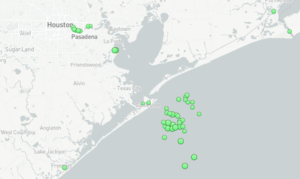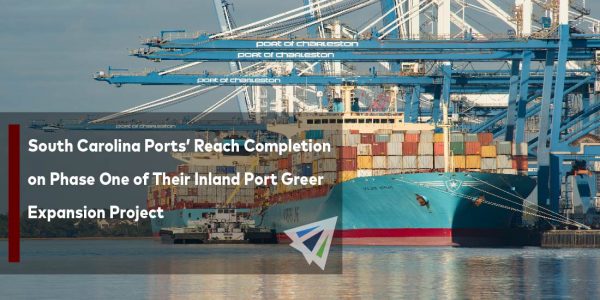Competitive Edge
December 7th, 2022
UPDATE: Negotiations for Gulf and East coast labor contract to begin 2023, Longshore union confident there will be no disputes
Leaders of the International Longshoremen’s Association (ILA) are expressing confidence that the union will secure a new six-year contract following the start of negotiations with the U.S. Maritime Alliance (the group that represents Gulf and East coast port employers).
The swift agreement to the two parties’ previous contract in 2018 supports the union’s claim that talks in 2023 will result in a similar fashion.
Of course, the same can’t be said for the West Coast and its ongoing negotiations. Since its start in early May, talks have stalled between the ILWU (the West Coast’s longshore union) and the PMA (the group representing port employers).
UPDATE: U.S. and Canada Ports – Number of Cargo Vessels at Anchor
• Vancouver: 37 Vessels at Anchor (+8)
• Savannah: 20 Vessels at Anchor (-6)
• Houston: 30 Vessels at Anchor (+10)
• San Francisco/Oakland: 9 Vessels at Anchor (+4)
• Los Angeles/Long Beach: 6 Vessels at Anchor (0)
• Mobile: 5 Vessels at Anchor (-3)
• New York/Newark: 6 Vessels at Anchor (+3)
• Charleston: 2 Vessels at Anchor (+1)
Note: Count taken on November 29, 2022. This count does not include vessels moored and being unloaded at port docks. Colored numbers in parentheses represents the change from last week over. Data is courtesy of MarineTraffic’s live vessel traffic map.
Have another U.S. or Canadian port you’d like us to track weekly? Let us know!
Takeaways
• U.S. West Coast: Last week, Los Angeles and Long Beach reported “zero” vessels queued offshore. In reality, there are six vessels at anchor. However, insiders say these remaining ships are waiting by choice.
Either way, the premier gateway of the USWC had minimal congestion. This is a far cry from the over 100 vessels waiting off its coast in early January.
• U.S. Gulf Coast: If you’re someone who only believes if you see, look below. Last week, reports revealed both export and import volumes in an out of Houston boosted in October. Yesterday, Houston had 30 vessels off its shore at anchor. Clearly, an indication of bustling freight activity for the Gulf’s largest port.

Yesterday, 30 vessels were at anchor outside of Houston. Image is courtesy of MarineTraffic.
• U.S. East Coast: Our count of Savannah’s queue revealed a strong week-over-week improvement. While its backlog remains the Achille’s heal to an otherwise minimally congested EC, we are optimistic that Savannah’s numbers will remain steadily falling.
• Canada: Just when Vancouver slipped under 30 for its vessel queue last week, Canada’s largest port only thought it’d be appropriate to revers that triumph. We can largely thank Vancouver’s outstanding issue of berthing delays for its endless sway of congestion.
IMPORT: Asia to North America (TPEB)
Recent Developments:
• West Coast contract negotiations between the International Longshore and Warehouse Union (ILWU) and Pacific Maritime Association (PMA) remain active. The existing labor contract between the two parties expired July 1.
• Rail congestion is considerable at most ports, including inland hubs.
Rates: Demand remains dropping. Spot rates are now at pre-pandemic levels. Transpacific service contracts of some shippers have been renegotiated to adjust with these market changes and deter shippers from opting for more favorable spot rates.
Space: Space is open.
Capacity: Capacity is very much open for transpacific trade. Carriers are struggling to match capacities with plummeting demand. Carrier’s overcapacity has spurred on blank sailings.
Equipment: Chassis availability is in a crunch in pockets, but with production amping up and lower import volumes coming through, there is hope of relief. Congested rail ramps remain an issue.
TIPS:
• Book at least two weeks prior to the ready date.
• For cargo ready now, take advantage of open space and softened rates on the spot market.
• Blank sailings are in play which may affect schedule integrity.
IMPORT: Europe to North America (TAWB)
Recent Developments:
• Labor-related tensions continue at Britain’s largest port, Felixstowe, as its dockworkers and port employers remain without a new labor deal.
• An easing market for this trade has afforede U.S. ports an opportunity to improve on their congestion and wait times.
Rates: Rates have fallen in December thanks to lower demand and carriers adjusting typical PSS fees.
Space: Space to both U.S. coasts have opened up as American port congestion overall eases.
Capacity: Capacity has improved, but not to the extent that was expected through November. Our eyes shift to Q1 2023 where more vessels will likely be shifted to this trade.
Equipment: Like it’s been for the past year, the equipment crunch is still an issue at European ports. Not much better at inland hubs, either.
TIPS:
• Book at least four weeks prior to ready date.
• Stay up to date with your forwarder and carrier advisories on anticipated added to this trade come 2023.
• Strongly consider premium services for no-roll options and improved reliability of cargo.
EXPORT: North America to Asia
Rates: Rates are stable.
Capacity: Capacity remains stable, except in pockets where it can be severe.
Equipment: Chassis and container deficits still exist at inland hubs, like Kansas City and Memphis.
TIPS:
• Book at least four weeks prior to the time of departure to secure necessary equipment.
• Stay in close communication with your provider and carrier to secure necessary equipment.
InterlogUSA Proudly Presents...

Offering insights into breaking news, market trends, our company’s history, and more.
“FreightFM” features short-form video interviews with InterlogUSA’s industry experts.
Did You Know: Legislation was signed into law to avert a rail strike
On December 2nd, President Biden signed a bill into law that locks rail workers into the labor agreement (through 2024) that was established in September by the Presidential Emergency Board – averting a rail strike.
Some benefits in this agreement for the workers include a 24 percent pay increases over five years from 2020 to 2024, immediate payouts that average about $11,000, and an extra paid day off.
We discussed this topic in significant detail in last week’s Interlog Insight’s newsletter. You can sign up for that newsletter here.
Source: CNBC
Freight News
Interim Measures for Processing Charge Complaints Were Recently Announced by the FMC
Recently, the Federal Maritime Commission, announced their interim procedures to review, investigate, and adjudicate Charge Complaints – of which can include a broad range of noncompliant charges assessed by a common carrier, including demurrage and detention charges.
These Charge Complaints are a part of the Ocean Shipping Reform Act of 2022 and been enacted into law since June, with the FMC receiving over 175 filings.
A Charge Complaint that is “perfected” with sufficient information and details is then swiftly investigated by FMC staff in the Office of Investigations. As follows, the common carrier will be contacted by Commission staff as part of the investigation and asked to respond to the complaint, and justify the charge or fee being investigated. As such, both parties are notified at the conclusion of the investigation – per the FMC website.
Now, if a common carrier’s charge is not in compliance, the Office of Enforcement will recommend that the Commission issue an “Order to Show Cause” to the common carrier under 46 C.F.R. § 502.91 to make a formal judgement on the Charge Compliant.
Next, the common carrier who receives the Order has to prove why it should not be ordered to refund the fees or charges paid or waive the fees in question. Thus, the FMC will initiate a decision on the Order to Show Cause, as well as the charges not in compliance with the law and will order a refund or waiver. They may also initiate a separate civil penalty proceeding with the FMC’s Administrative Law Judge for possible penalties under 46 U.S.C. §§ 41107 and 41109.
After the FMC gathers more experience from the first proceedings, they will then be able to figure out what form a permanent process should take.
Southeast Ports Continue to see Demand Increase
The shift of cargo from the U.S. West Coast to the U.S. East and Gulf Coast continues to remain relevant.
As the Port of Los Angeles saw throughput fall 25 percent year over year in October, the Port of Savannah experienced a 2 percent year over year climb, and the Port of Charleston hit 7 percent in annual growth – Freightwaves reports.
When these USWC to USEC/USGC shifts happen due to challenges at the ports, typically, the volume does not shift back quickly after those challenges have resolved. Meaning, the USEC and USGC can expect to see this shift in cargo increases to continue.
Georgia Port Authority (GPA) expressed how customers are continuing to bring new and expanding business to the Port of Savannah – as this port links to major U.S. markets drawn by global connectivity and the supply chain network.
Additionally, the GPA announced they will break ground early next year on a project that will build two post-Panamax berths at its Ocean Terminal in Savannah. Turning into what is usually a breakbulk terminal into a more modernize container facility, per the Journal of Commerce.
It will be interesting to see throughout the beginning of next year and throughout, if this shift does continue or if more cargo shifts back to the USWC.
Missed Last Month's Webinar? Watch Here Now!
Sign Up for This Month's Webinar
Our next webinar will be on Wednesday, December 21st – Time: TBD
Additionally, stay tuned for the announcement of
who our next special guests will be!
Finally, we would like to hear from you!
If you have any questions or topics you would like our experts
to discuss in future webinars, please let us know!
You can email us at sales@interlogusa.com
Interlog  Insights
Insights
In last week’s newsletter, we introduced a new segment, our Magic Freight Ball Predictions – of which we will go into more detail, in our upcoming newsletter that will go out this Friday.
We also discussed Chinese New Year, legislation being passed to avert a nationwide rail strike and what could have happened if a rail strike were to happen, and more!
Sign up for the latest insights today!
Sign up for our
industry answers
Our team works to provide valuable, unique, and relevant content to assist you in finding solutions. Sign up now.

